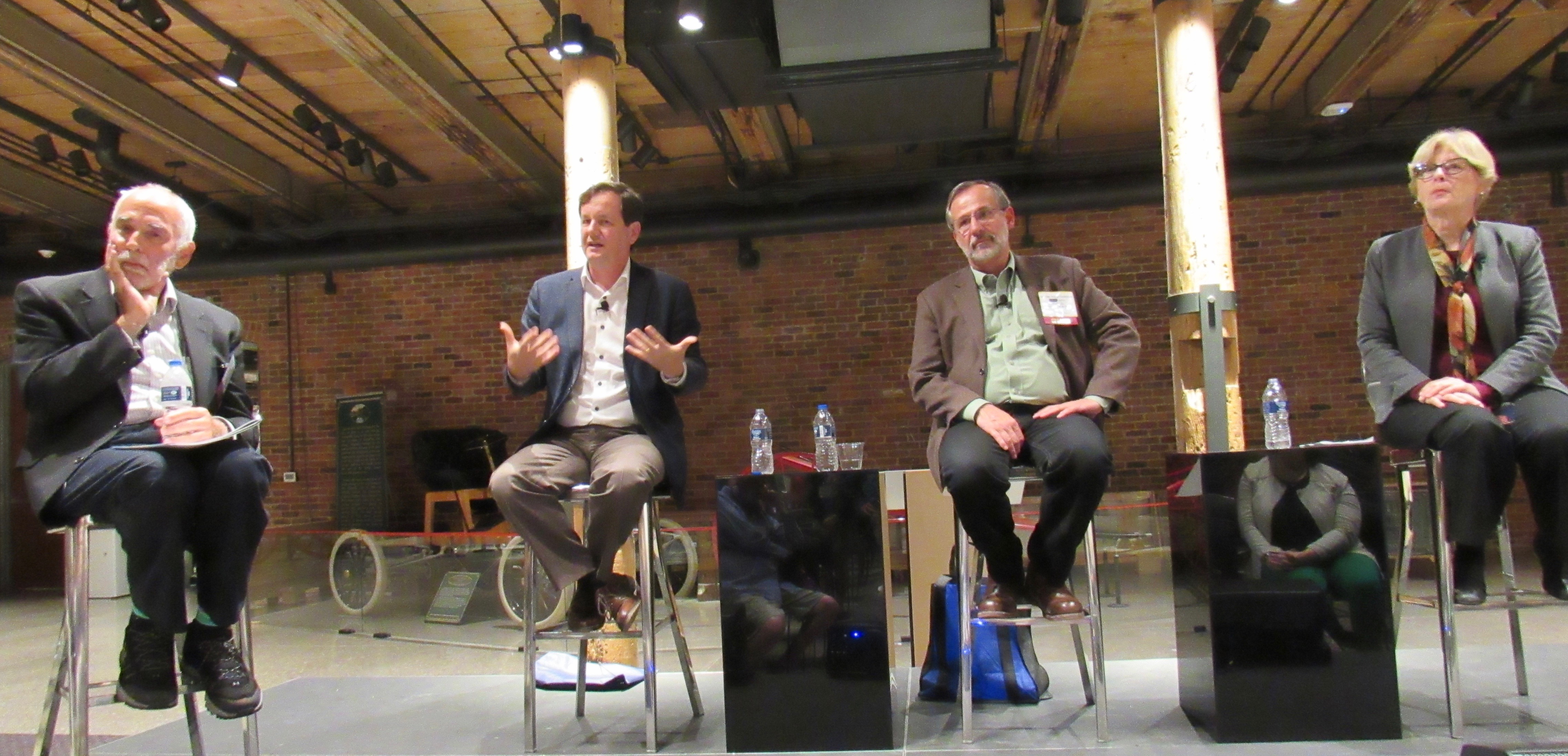By Harold C. Ford
A panel of automotive futurists anticipated the next great transportation transition for the human species during the first day of the Society of Environmental Journalists’ (SEJ) 28th Annual Conference in Flint, Oct. 3-7. That transition will likely leave behind individually-owned, gas-burning cars and trucks as travelers opt for autonomous, electric, shared vehicles.
Panelists included: freelance environmental journalist Jim Motavalli who served as moderator; Michael Ableson, vice president of global strategy for General Motors (GM); John DeCicco, a research professor at the University of Michigan Energy Institute; and Michelle Krebs, an automotive writer for Autotrader.
Given the current popularity of cars and trucks in the U.S., the panelists’ predictions varied widely as to when this transition will begin in earnest. Nonetheless, they were unanimous in forecasting major disruptions of American transportation systems and the business models that sustain them. Uber and Lyft were cited as but two examples of new transportation models that will continue to emerge in the 21st century.
Motavalli flatly predicted, “The future of the car is autonomous, electric, and connected.” But future generations will have to decide if vehicles are privately owned or shared, he said.
 GM’s Ableson claimed that the future is now. GM has deployed the plug-in hybrid Chevrolet Volt as part of its fleet since 2010. However, the buying public is hardly rushing headlong into the plug-in hybrid market. Sales of the Volt and a few other related models have accounted for about 100,000 sales worldwide from 2010 to 2015, he said. That’s a small drop in the automotive ocean of an estimated one billion vehicles on the planet, a number that is expected to double by mid-century.
GM’s Ableson claimed that the future is now. GM has deployed the plug-in hybrid Chevrolet Volt as part of its fleet since 2010. However, the buying public is hardly rushing headlong into the plug-in hybrid market. Sales of the Volt and a few other related models have accounted for about 100,000 sales worldwide from 2010 to 2015, he said. That’s a small drop in the automotive ocean of an estimated one billion vehicles on the planet, a number that is expected to double by mid-century.
Ableson touted OnStar, a subscription-based communications system launched in 1996, as a step toward transportation connectedness. OnStar services include hands-free calling, turn-by-turn navigation, in-vehicle security, emergency services, and remote diagnostics systems. OnStar boasted six million subscribers by 2011.
GM’s future moves will include deployment of “an autonomous, truly driverless vehicle in a ride-sharing service, an electric vehicle next year in 2019,” according to Ableson. He also said GM’s “current portfolio plan”includes 20 new autonomous, electronic vehicles with zero emissions by 2023.

“Future of the Car” panel at Factory One Oct. 4 (from left, Jim Motavalli, Michael Ableson, John DeCicco, Michelle Krebs (Photo by Harold C. Ford)
Uncertain future to be shaped by market demands:
Motavalli judged the transition timeline to be uncertain. “The crystal ball remains a little bit murky in terms of the timetable,”he said. “When it happens the change will be profound. It will be a new ecosystem of mobility and accessibility that will have to co-evolve with the new landscapes, with new ways that we use buildings, and it’s entirely unpredictable.”
Krebs predicted that 2023 to 2025 will be key years, “an inflection point,” a time of significant change from personal ownership to fleet ownership of autonomous vehicles. “The model has to change how we acquire transportation,” she said. “We think the future is a sharing future.”
Krebs asserted that safety concerns will help determine the market for autonomous vehicles. She cited the alarm generated by a fatal accident involving a self-driving Uber vehicle in Tempe, Arizona the night of March 18. That car struck and killed a 49-year-old woman walking her bicycle in the middle of the road.
That single death, though unfortunate, pales in light of the grisly carnage caused by manually operated vehicles on American highways year after year. Auto accident fatalities regularly exceeded 50,000 in the 1960s and 1970s, according to various agencies such as the National Highway Traffic Safety Administration. In the 1980s and 1990s, through 2007, annual fatalities surpassed 40,000, declining to about 34,000 to 35,000 per year since then.
“We have to prove to (consumers) that there is an enhancement in their lives and safety is one of the biggest ones,” Krebs concluded.
DeCicco posited that “educating consumers” about the advantages of new transportation models will grow the American appetite for new modes of transportation. “Fifty percent of Americans don’t understand anything about electronic vehicles and education about them is an important goal,” he argued.
Ableson reasoned that as the public moves into sharing fleets, transportation’s cost per mile will go down and that will incentivize consumers to make different and better choices.
DeCicco noted that the health of the national economy will help to determine the future of the auto industry. As the economy recovered from the Great Recession of 2007-2009, there was a shift back to pickup trucks, he said. “Customers willingly pony up.”
The accommodation of personal possessions will also help to determine consumer appetites for new modes of transportation. “People like to have their stuff in the car,” Motavalli said. Ableson speculated that a “peer-to-peer sharing” model might address the matter of personal items.
Urban areas to lead the way:
Panelists agreed that urban areas are more likely to lead the way to future transportation models. “Sharing depends on ride density,” Ableson said. Urban areas are more favorable to sharing systems. “It may never work” in rural areas, he said.
Krebs agreed and added that young people who are more accepting of new transportation models may help lead the way. Sharing might reduce multiple-car families to one-car families, she said. Subscription services with monthly fees might provide access to a variety of vehicles. “You may own a car,” added Ableson, “but you may also share that car with another.”
An exception to the urban-rural paradigm may be long-distance hauling, Krebs said. “There’s a shortage of long-haul truck drivers,” she said, and automated vehicles may resolve that shortage.
No matter the advantages, Ableson argued that mass acceptance of sharing models to be distant. “We think personal ownership is going to last for a long, long time,” he said.
Electric vehicles:
The tepid consumer response to GM’s Chevy Volt exemplifies the challenge of auto companies to market electric vehicles (EVs). “Consumers don’t (currently) choose electric vehicles,”stated Krebs. “Last year, .6 percent purchased electric vehicles.”
According to DeCicco, cost, capacity, capability limitations, and charging barriers may well determine the future acceptance of EVs.
Ableson agreed that EVs are currently best suited for “stop-and-go city driving.” “They’re fabulous,” he said. But he agreed that they are presently unsuitable for longer trips because the amount of energy that can be stored in batteries and fuel cells is not sufficient for longer trips.
DeCicco lamented the “overemphasis on electric vehicles.” He cited data that shows consumers are not currently interested in them because “they do not connect the dots”between personal ownership of autos and concern for the environment. He likened the push for EVs to “trying to push a wet noodle up a hill.”
Autonomous “wild card”
“Automation is the real wild card,” DeCicco declared.
Ableson agreed. “Full automation is the nut that needs to be cracked before we see some of these other things fully play out,” he said. Automation success will help with the goal of electrification of vehicles.
Nonetheless, DeCicco said he is uncertain about the ultimate impact of autonomous vehicles. “It’s very unclear whether it’s a net positive or a net negative,” he advised. “The positive vision gets a lot of airplay.”
Autos and environment:
The impact of autos on the environment seems obvious by now. About 75 percent of carbon monoxide emissions come from automobiles. It’s worse in urban areas with autos contributing up to 90 percent of air pollution.
Land use is another concern, particularly in metropolitan areas. Some 40 to 50 percent of land area in urban centers is devoted to the automobile, observed Motavalli. “We need to get people out of their SUVs into EVs,”he said.
Ableson flatly stated GM’s future goals: “Zero emissions, zero crashes, zero congestion.”
“Unfortunately, we have a pretty darn broken system,”declared DeCicco. “We’re going to be burning a lot of liquid fuel for a long time.” He said his concerns were the number of autos, fuel efficiency, automation, electrification, and connectivity.
China shows the way:
Panelists seemed to agree that Asian nations and cities are leading the way in developing new transportation systems. That development may be spurred by air pollution, congested cities, a less litigious legal environment, and greater governmental influence on infrastructure decisions.
“China is the country that’s done the most to introduce electric cars,” observed Motavalli. “They are very committed to the future of the (electric) car,” he said. “It’s a very different equation in China.”
DeCicco pointed to “less litigious” China as a nation that is “rethinking” how automobiles co-evolve with new landscapes, including buildings. He sees China as a place where a more rapid acceptance and development of autonomous vehicles is likely to happen.
Motavalli observed that traffic congestion in many Asian cities is many times worse than in the United States. He noted that an urban area near Beijing is being developed with a full embrace of “21st century technology including automated mobility systems.”
Ableson said that China and Europe are pressing ahead with electric vehicle development independent of what the U.S. is doing. He judges the U.S. to be in the lead in terms of autonomous vehicle development.
Repurposing:
“We’re not talking about getting rid of cars,” said Motavalli, “we’re talking about repurposing them.” He noted that cars are used only five percent of the time; 95 percent of the time they are in nonuse.
“Without sharing, we’re looking at two billion cars on the planet,” Motavalli continued. “With sharing, we have the opportunity to reduce the car fleet by 40 to 50 percent. Large parts of cities can be repurposed away from automobiles to other uses. We’re looking at the end of the parking garage, the end of the driveway at the suburban home.”
Past, present, future:
Ableson noted the irony of the location, Factory One, for a panel discussion about the future of the automobile. Factory One is one of the seminal sites that marked the transition of human transport from horse-drawn carriages to motorized vehicles.
In 1887, Factory One began as a building place for the production of horse-drawn carriages. Auto pioneer Billy Durant eventually lured inventor David Buick to Flint and Factory One became one of the original incubators for Buick automobiles.
Early in the 20th century, Buick sales exceeded that of any other car company and Durant parlayed that success into the formation of General Motors on Sept. 16, 1908. Years later, Durant looked back at Factory One and said that he could trace all of his business enterprises to the building where he started in 1887.

Harold C. Ford (Photo by Jan Worth-Nelson)
An important moment of transition and disruption unfolded at Factory One a century ago. As for the transition and disruption about to unfold in this century, panelist DeCicco may have stated it best with a simple prediction: “Ultimately, it is what we as a society want it to be.”
EVM staff writer Harold C. Ford can be reached at hcford1185@gmail.com.


You must be logged in to post a comment.